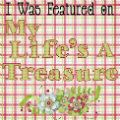In January 2008, I left my yearly mammogram feeling very squished and bruised. Way more than the usual squash. Next time, I decided, I would go some place else. But with five of my children at home, my job teaching disabled children, and life in general, I had put that unpleasant experience completely out of my mind. The time to make my appointment rolled around. I had gotten in the practice of yearly mammograms when my friend Lori shared that she took a day in January each year to take care of the womanly exams. So much of what we do as wives and mothers we do for others, this she did for her. I considered postponing the exam. But with Lori's words ringing in my ears, I reluctantly made the appointment for January 29, one year and a day since that last bruising mammogram.
I almost did not make the appointment that saved my life. Putting it off to find a different location would have been completely understandable. I do not have any lifestyle related breast cancer risk factors. There isn't a history of breast cancer in my family. I gave birth to three children, and adopted three more. I breastfed my babies. A doctor told me that I don't drink enough alcohol. My three to six drinks a year, did not impress him. I never smoked. I was fifty years old. While no one is immune to breast cancer, I thought these things offered me some protection from it. I never thought it would happen to me.
There are varying guidelines out there about when to have a mammogram. The Mayo Clinic offers these guidelines:
Most women who get breast cancer do not have a family history or other known risk factors for the disease. In the United States, one out of eight women will be diagnosed with breast cancer.
- Breast health awareness, which includes a woman becoming familiar with her breasts in order to identify breast abnormalities or changes, and to inform her doctor of any changes that may need further evaluation
- Clinical breast exam performed by a health care provider and recommended annually beginning at age 40
- Screening mammography beginning at age 40
If you are younger than 40, I suggest that you have a yearly breast exam by a doctor. I met women in their twenties and thirties with breast cancer. If you are in your forties follow the guidelines above.
I am a wife and mother. I am a special education teacher. I am not a doctor. Still I will tell you this, early detection saves lives. It saved mine.
There is a time for everything,
and a season for every activity under the heavens:
a time to be born and a time to die,
a time to plant and a time to uproot,
a time to kill and a time to heal,
a time to tear down and a time to build,
a time to weep and a time to laugh,
a time to mourn and a time to dance,
a time to scatter stones and a time to gather them,
a time to embrace and a time to refrain from embracing,
a time to search and a time to give up,
a time to keep and a time to throw away,
a time to tear and a time to mend,
a time to be silent and a time to speak,
a time to love and a time to hate,
a time for war and a time for peace. ~ Ecclesiastes 3:1-8







































